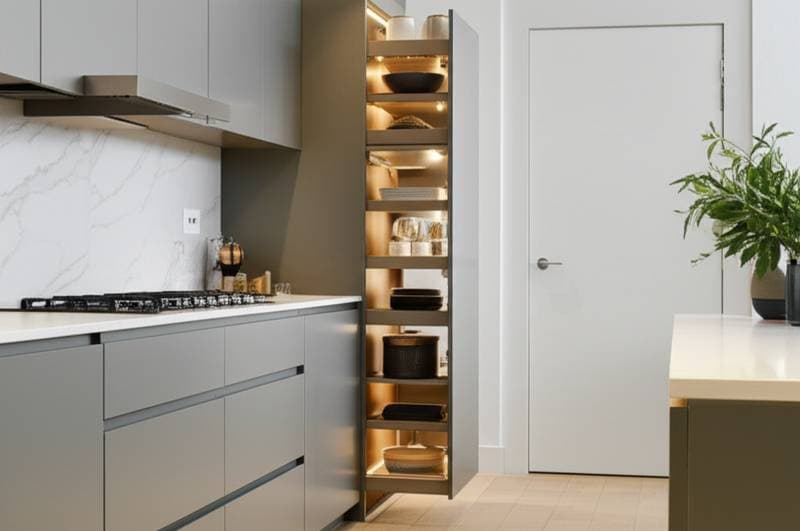Hidden Storage Walls Transform Small Kitchens
In compact kitchens, every surface serves with clear intention: countertops function as both preparation areas and display spaces, while cabinetry offers storage along with balanced proportions. One innovative development in modern kitchen design involves hidden storage walls, which conceal cooking essentials behind sleek panels and create a unified architectural element that expands available space significantly.
This design choice focuses on establishing order and minimizing visual distractions, which allows the kitchen to transition smoothly from a busy cooking area to a peaceful living space. Homeowners and designers recognize that these walls can fundamentally change how small kitchens feel and function, often increasing usable space by up to 40 percent through clever organization.
Hidden storage walls achieve this transformation in several key ways, each addressing common challenges in limited spaces. Below, explore five practical approaches that demonstrate their value.
1. Modular Adaptability for Custom Layouts
Hidden storage walls excel through their modular design, which allows users to configure compartments according to specific needs. For instance, adjustable shelving can accommodate varying heights for pots, pans, or small appliances, while pull-out drawers organize spices and utensils efficiently.
Professionals in kitchen design often recommend starting with a floor plan assessment to identify high-traffic zones, then incorporating modular panels that blend with existing decor. This method not only maximizes vertical space but also ensures easy access, reducing time spent searching for items during meal preparation. Homeowners who implement this can expect a more streamlined daily routine, with measurable improvements in efficiency within weeks of installation.
2. Integration of Lighting and Technology
These walls go beyond basic storage by incorporating built-in lighting and technological features that enhance usability. LED strips positioned along shelf edges provide focused illumination when panels open, which creates an inviting workspace without overwhelming the room.
Design experts suggest selecting systems with integrated outlets for charging devices or powering appliances directly from the wall, eliminating the need for visible cords. This integration maintains a clean aesthetic and supports modern cooking habits, such as using smart devices for recipes. As a result, the kitchen becomes a multifunctional hub that feels both advanced and understated.
3. Seamless Blending with Living Areas
Hidden storage walls help kitchens merge effortlessly with adjacent living spaces, which is essential in open-plan homes. Panels designed to match wall finishes or furniture create a continuous visual flow, making the area appear larger and more cohesive.
To achieve this, measure the room's dimensions precisely and choose materials that complement the overall palette, such as matte finishes for a subtle effect. This approach reduces the sense of confinement in small kitchens and encourages social interaction, as cooking areas no longer dominate the environment visually. Users often report a heightened sense of spaciousness, transforming compact layouts into welcoming zones for gatherings.
4. Precision Zoning for Everyday Tools
Success in hidden storage walls comes from tailored zoning that organizes items based on daily use. Dedicate sections to categories like baking supplies or breakfast essentials, with features such as vertical dividers for trays and built-in hooks for tools.
Experienced designers emphasize mapping out usage patterns first, then creating zones with easy-to-reach compartments. For example, shallow doors can house glassware, while deeper sections store bulkier items. This organization fosters a calmer atmosphere and smoother workflows, allowing cooks to focus on creativity rather than clutter management.
5. Enhanced Durability and Maintenance
These walls incorporate durable materials that withstand daily wear, ensuring long-term functionality in busy kitchens. Options like moisture-resistant composites prevent warping, while smooth surfaces simplify cleaning routines.
To maintain these systems, establish a regular schedule for wiping down panels and reorganizing contents, which preserves their appearance and efficiency. This focus on durability means hidden storage walls remain effective for years, providing ongoing space savings and aesthetic benefits without frequent replacements.
Why This Matters for Modern Homes
Small kitchens represent opportunities for creative solutions rather than limitations, and hidden storage walls exemplify this potential by combining practicality with refined design. They address the need for multifunctional spaces in urban living, where efficiency and style must coexist.
From a practical standpoint, these walls solve storage shortages and organization issues that plague compact areas. Aesthetically, they introduce a sense of architectural elegance, making every square foot feel purposeful and serene. As design trends evolve, more accessible modular options make this innovation available to a wider range of budgets and home sizes.
Implementing hidden storage walls begins with evaluating current space constraints and selecting adaptable components. Measure walls accurately, prioritize high-use items for zoning, and integrate subtle lighting for added convenience. Within a month, most users notice reduced clutter and improved flow, which enhances overall home satisfaction.
This design trend aligns with broader shifts toward sustainable, flexible living environments. By concealing essentials without compromising access, hidden storage walls create kitchens that support both daily tasks and long-term well-being, proving that smart storage can redefine how we experience our homes.










